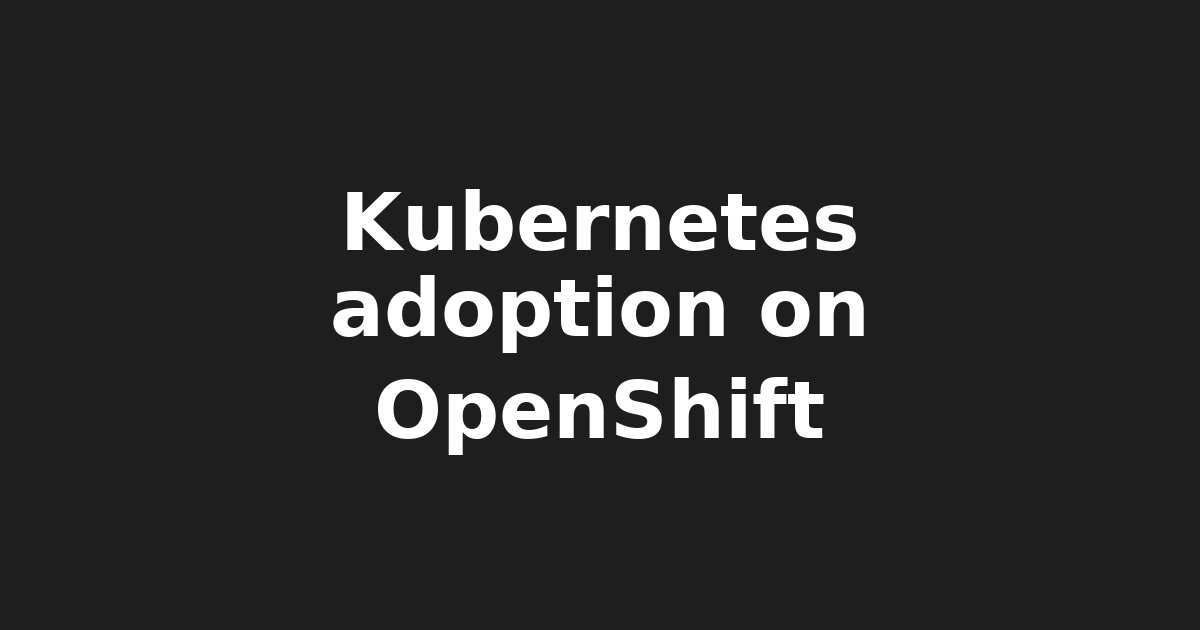Kubernetes on OpenShift: Top Trends and Adoption Strategies

Kubernetes on OpenShift: A Comprehensive Guide to Cloud-Native Applications
=====================================================
In recent months, Kubernetes on OpenShift has gained significant attention among enterprises due to its increasing popularity and adoption. In this article, we will delve into the world of Kubernetes on OpenShift, exploring its relevance, benefits, and best practices for building cloud-native applications.
Simplified Cluster Management
OpenShift provides a managed platform for deploying, scaling, and managing Kubernetes clusters, making it easier for developers and system administrators to focus on building applications rather than managing infrastructure. With OpenShift, users can:
- Deploy and manage clusters with a single click
- Automate cluster upgrades and patching
- Monitor cluster performance and health
This simplified cluster management provides several benefits, including reduced administrative overhead, improved scalability, and increased reliability.
Streamlined CI/CD Pipelines
With OpenShift, users can automate the build, test, and deployment of their applications using pre-built templates and automation tools like Jenkinsfile, GitHub Actions, or GitLab CI/CD. This streamlined approach to CI/CD pipelines enables:
- Faster time-to-market for cloud-native applications
- Improved consistency and reproducibility across environments
- Reduced risk of human error in manual testing and deployment processes
Enhanced Security
OpenShift provides built-in security features, such as network policies, secret management, and authentication/authorization, to ensure that applications are secure and compliant with industry standards. These security features include:
- Network Policies: Control access to cluster resources based on labels, namespaces, and pods
- Secret Management: Store sensitive data securely using Kubernetes Secrets or OpenShift ConfigMaps
- Authentication/Authorization: Use OpenShift's built-in authentication mechanisms to control access to cluster resources
Increased Adoption in Enterprise Environments
Many large enterprises have started adopting Kubernetes on OpenShift due to its ease of use, scalability, and reliability. This increased adoption is driven by:
- Growing Demand for Cloud-Native Applications: The increasing adoption of cloud-native applications has led to a growing demand for managed platforms like Kubernetes on OpenShift.
- Advances in Containerization and Orchestration: Advances in containerization and orchestration have made it easier for developers to build and deploy cloud-native applications.
Relevant Tools and Technologies
1. OpenShift
OpenShift is an open-source container application platform that provides a managed platform for deploying, scaling, and managing Kubernetes clusters.
2. Kubernetes
Kubernetes (also known as K8s) is an open-source container orchestration system for automating the deployment, scaling, and management of containerized applications.
3. Docker
Docker is a containerization platform that enables developers to package, ship, and run applications in containers.
4. Jenkinsfile
Jenkinsfile is a Groovy-based configuration file used by Jenkins to automate build, test, and deployment processes.
5. GitHub Actions
GitHub Actions is a CI/CD platform integrated with GitHub repositories, enabling developers to automate build, test, and deployment processes.
6. GitLab CI/CD
GitLab CI/CD is a CI/CD platform integrated with GitLab repositories, enabling developers to automate build, test, and deployment processes.
7. Network Policies
Network policies are Kubernetes network management features that control access to cluster resources based on labels, namespaces, and pods.
8. Secret Management
Secret management refers to the practice of securely storing sensitive data using Kubernetes Secrets or OpenShift ConfigMaps.
9. Authentication/Authorization
Authentication/authorization refers to the process of verifying users' identities and granting access to cluster resources based on their roles and permissions.
Real-World Examples
- IBM: IBM has adopted Kubernetes on OpenShift to deploy its cloud-native applications, leveraging the platform's managed Kubernetes clusters and streamlined CI/CD pipelines.
- Intel: Intel uses Kubernetes on OpenShift to manage its containerized applications, taking advantage of the platform's advanced security features and scalability.
Conclusion
Kubernetes on OpenShift is a powerful platform for building and deploying cloud-native applications. By leveraging this platform, developers and system administrators can simplify cluster management, streamline CI/CD pipelines, enhance security, and increase adoption in enterprise environments.
As the demand for cloud-native applications continues to grow, it's essential to stay informed about the latest trends and best practices in Kubernetes on OpenShift. With its managed Kubernetes clusters, streamlined CI/CD pipelines, and advanced security features, OpenShift is an attractive choice for organizations looking to modernize their infrastructure.
References
- OpenShift Documentation: https://docs.openshift.com/
- Kubernetes Documentation: https://kubernetes.io/docs/
- Docker Documentation: https://docs.docker.com/
Note: The information in this article is based on the latest available data and sources as of 2025. However, please note that technology and trends evolve rapidly, and it's essential to stay up-to-date with the latest developments in Kubernetes on OpenShift.
